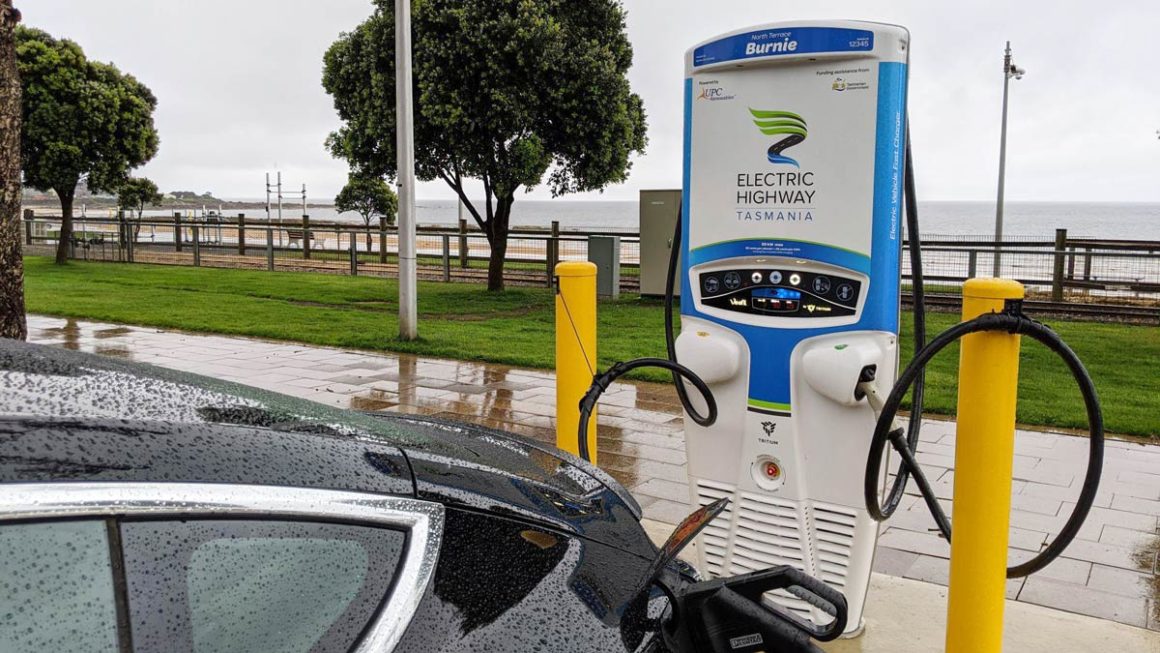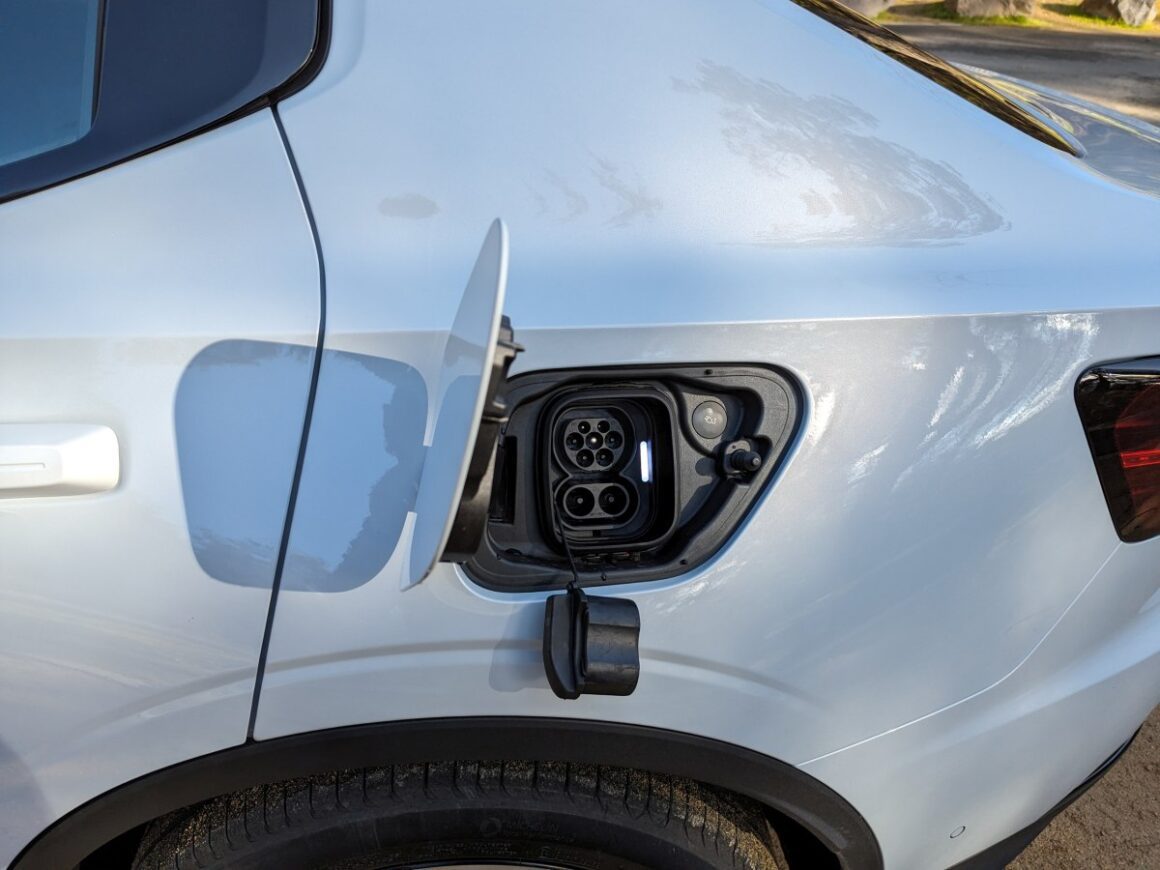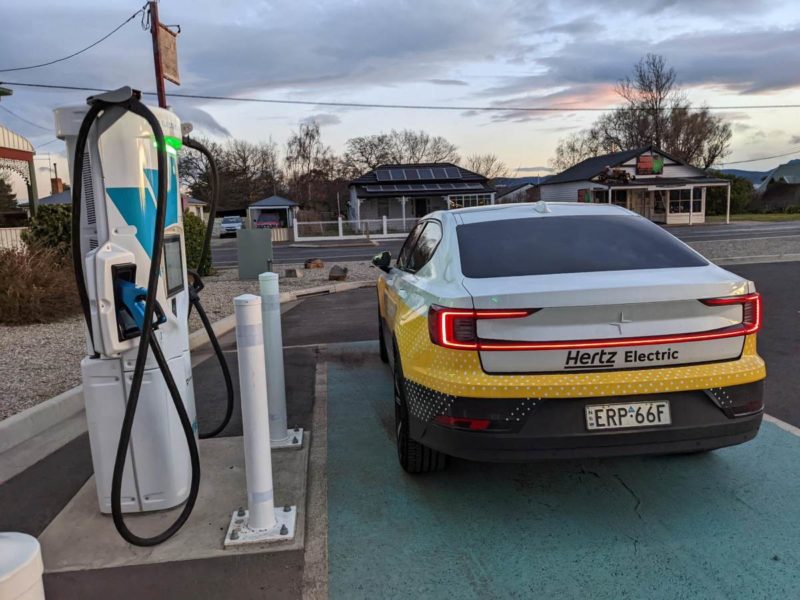Recently, I was based on the north coast of Tasmania for several days. Some local travel was necessary, so I looked to hire a car. I was delighted to secure one of the two Polestars held by Hertz/Thrifty at Devonport Airport.
I was surprised to get an EV in this location and surprised it was available from Hertz. A few years ago, Hertz US bought thousands of Teslas for their fleet.
Then news came Hertz were dumping their EV fleet due to low resale prices, high maintenance costs and dissatisfied first-time EV users who had been poorly briefed by disengaged staff who did not ensure the vehicle was charged or provide suitable briefings.
Things could not be more different at Devonport Airport.
The staffer behind the counter was positive about electric vehicles and told me the Hyundai dealer in town had a new charger that was not yet up on Plugshare. The Polestar’s battery was completely full and ready for 450km – one third more range than a basic Tesla Model 3.
I did not need an EV briefing at the counter as our household has borrowed, car shared and rented several EVs. We used to own a BYD T3 van and now have a second-hand Tesla 3. But we did get a short Polestar course that included the manual way to pop the boot and the lock and unlock buttons on the cigarette-packet sized key fob.
I should have paid more attention.
The Tesla locks and unlocks itself by sensing the proximity of your phone. When it senses you walking away, the car locks, beeps, flashes and – this bit is clever – folds back the side mirrors providing audio, visual and physical confirmation.
Polestar owners also use their phone, but hirers from Hertz get the little box which I assumed was a fob (like the one for the BYD van) that you must use to lock or unlock the vehicle.
I parked the Polestar near where I was staying and booked into our accommodation. At 4am the next morning I awoke with the complete certainty that on leaving the car I had not pressed the lock button on the key ring. Nor could I remember seeing a flash or hearing a beep.
Back down in the cold and silent car park, I could not tell if the car was locked or not as the Polestar mirrors do not move. The car and I began to converse in button presses and flashes, but we did not understand each other. Each time I pressed the lock button on the box, I could still open the door. Eventually, by leaving the little box some distance away on the footpath I confirmed that the box was a proximity device that functioned like the app on the phone. Back to bed.
The next day, I parked the car, made sure I had my phone but forgot to take the box with me. Fifteen minutes later I realised I had left the little box in the car and the car was unlocked and ready to drive away. Fortunately, it appears that EV theft is at low levels in northern Tasmania.
You will not be surprised to hear that the main challenge was charging.
Charging is a challenge for Hertz. There is plenty of power at the airport. The planes get plugged in to charge the batteries that start the turboprop motors. But Hertz only has access to standard power points. When people bring the cars back empty, a hire vehicle can be out of action for 24 hours while it is being recharged.
The alternative for Hertz is to drive them 10km back to the Devonport fast charger. These charging difficulties caused Hertz to transfer most of the Devonport EV fleet to Launceston.
For EV hire customers, the refuel-and-return rules are much like those for other cars. If you bring the car back with less than 80% charge, you pay for the kilowatt-hours needed to recharge to that point. If you bring the car back with 20% charge, you pay for the recharge and an additional $10.
For this reason (and out of courtesy) when returning a hire EV to the depot you must devise a refuelling plan.
One solution is to plug in at your accommodation. The Polestar had all the necessary cables in the ‘spare wheel’ pit in the boot. Unfortunately, I could not plug in where I was staying. So my plan had to be based on a public charger.
Many discussions about electric vehicles revolve around range anxiety. Those of us familiar with EVs know that it is not non-users who are most anxious about range. The main anxiety felt by EV users is triggered by mid-trip charging.
Like the stages of grief, there are several stages of charging anxiety. On my way back to Devonport Airport I passed through each of them.
The first stage of anxiety is caused by the scarcity of fast chargers. This scarcity is not surprising. Fast public chargers are expensive, perhaps $100,000 each. Fast chargers use a lot of power, and it is difficult to find a site on the distribution system with sufficient surplus power and an agreeable ‘landlord’ who offers reasonable terms.
Once installed, the charge point provider needs lots of people to use the charger, so they can recover their investment and a bit more. This is a chicken and egg problem. No-one will install a charger until lots of people are ready to use it and no-one will use an EV until there are plenty of chargers. This first cause of charging anxiety will be with us for some time.

On the north coast of Tassie today, fast chargers are somewhat scarce. There are some in Burnie, and some in Devonport. There is also a Tesla charge site near the Devonport ferry, but Tesla’s red tape prevents the other classes from using the facility. Even Tesla owners who are borrowing a Polestar may not use the Tesla chargers.
The second stage of charging anxiety is caused by sign up and software. You can tap and pay at BP and Shell, but when charging you must sign up with each provider. Set up takes a bit of time and the connect, start, stop, and pay process is different on each system.
The severity of this cause of charging anxiety is low for me as our household is a frequent user of public charging. Both the BYD van and now the Tesla live at the kerb and cannot be connected to our domestic power, so we regularly use the blue and orange public re-fuelling companies and have their apps and payments systems ready to go.
These days we also use the red Tesla public chargers. Here the process is as it should be. Your phone stays in your pocket. The car senses the charge point and pops open the ‘petrol cap’. You must insert the plug and return it to the pillar when the charge is over, but the robots do the rest. The other charging companies are approaching this standard. Evie has just introduced auto pay.
I mention this second cause of anxiety because, anecdotally, it seems that EV-owning charge-at-home households rarely charge mid-trip. Some people we know have never used the public system and others consciously avoid it. If you are a home alone charger and you plan to hire an EV, I suggest you do a few public sessions locally to get set up and familiar with the different providers.
The third stage of anxiety is generated by the location of the charge site and the layout of the bays. At a service station all is obvious and convenient. This is not the case for public chargers.
On my refuel and return trip to the airport I headed first to the Hyundai dealer. The car navigation brought me to the dealership but on the unfamiliar roads I overshot the driveway and had to find somewhere to turn around.

Once inside the dealership, the charge bays were obvious, and it was easy to drive straight in and park nose to the wall at the charger. Unfortunately, the Polestar charges at the rear. From the driver’s seat I could not see how long the cable was. Perhaps I would need to back out, do a 9-point turn in a constrained area in an unfamiliar car and then reverse into the charge point.
I also saw that these newly installed chargers were 24s – half the claimed speed of the fast charger in town. Nor was the location attractive. All around the Hyundai dealer were other car dealers and very few parks, waterfronts, or coffee shops. So rather than turn around and plug in, I rolled back out onto the road and headed for the Chargefox charger in town.
This unit is inside the Council multi-deck car park which was easy to find and enter. The Council goes to the trouble to charge you a couple of dollars to be in the car park, but it is their land, and the location is near interesting things to do with your charge time.
Now to find the charge bay which the sign said was on the ‘upper’ level. A search of Level 1 revealed that upper meant Level 2. This search was nothing like as difficult as the search for a well-hidden site at one NSW shopping centre. There I ended up parking at the kerb and going for a walk through the carparks to find it.
The next challenge was to get the car’s charge point near the charge plug. As you probably know, the charge point or petrol cap on a car can be on the left or right, front, middle or rear. To deal with this, over many decades service stations have evolved a corridor-based design that allows you to approach the bowser from either side and come to a stop where the hose can reach the petrol cap.
These decades of experience have been put aside by charge point locators who prefer to locate a charge point, not alongside a corridor, but on the wall at the end of the hall. This requires the newly charged vehicle to reverse out (or in) to the bay rather than drive forward and away.
In Devonport the charge point is not only against a wall it is in a corner. Instead of four bays being available, two for each cable, in Devonport the site designer has cut the usable bays to 3. At least the bays are at right angles, unlike the strangely angled charge bay at the service station just out of Melbourne designed by an ill-natured driving instructor.
The fourth stage of anxiety is the charge point itself. Sometimes they are out of order (although you can check that on the app). Sometimes they go Bang in the middle of a charge and shut down. Sometimes the communications do not work, and the power will not flow. A phone call can be necessary.
I was able to skip that stage of anxiety in Devonport. I knew the power was on because in the lefthand corner bay there was a vehicle taking in a charge.
I was disappointed but not surprised to see the unit was only delivering 30kW rather than 50kW. This type of under delivery is common. One of the Tesla sites we used promised speeds of 150kW but delivered only in the mid 30s.
Now to the fifth stage of charging anxiety, the cables, and connectors. Although charge points have two cables, they can usually only charge one vehicle at a time. Typically, one cable is set up for Nissan, Lexus, and friends, the other for the Type 2s including they Polestar (and Tesla). In my view it is time to issue the minority with adaptors and make all charge points Type 2 as this would assist in queueing which we will look at shortly.
In Devonport the Type 2 lead was on the left in the corner. The vacant bay was on the right and the Polestar charges on the left rear. This required me to back the Polestar in at an angle so that when it was my turn, I would be able to stretch the left-side cable over to the far side of the Polestar. If both cables had been Type 2, I could have plugged in and waited for my turn.
Despite all the above, at this point, I was feeling pleased. I had passed through most of the stages of charging anxiety. I had found the site; the charger was working and running at reasonable rate, and I was next in the queue. I was also on time. I had allowed 90 minutes for refuelling.
Half this time I hoped would be charging. The other 45 minutes were a buffer to allow for queueing, low charging speed and calling the company about a technical fault. After 90 minutes I needed to get out to the airport to catch my flight.
My optimism was misplaced. I had yet to pass through the sixth and main stage of charging anxiety – human behaviour.
Society has evolved two simple ways of handling situations when many people want to use a single facility. One is to book a time slot, perhaps by putting down a deposit. The other is the queue.
Car share systems like GoGet work through bookings. If you want to use a car, you look it up and see when it is available – just as you would check access to a meeting room at work. The same system could be used at the public charger. Perhaps you would put down a deposit of $20 to secure access to the charger for 45 minutes. If your charge cost $15 you would be refunded the balance.
With a booking system I could have locked in my charge time ten days earlier when I booked my flight and hire car.
Unfortunately, none of the charge providers have installed a booking system.
Instead, we must rely on a queue. A couple of years ago there was no structure to the queues. Recently charging systems have begun to implement queueing systems but they are rudimentary and weak.
Chargefox recognises that drivers can overstay and imposes a fee ($1 a minute) on a vehicle that remains plugged in 10 minutes after it has finished charging. This is the right method to prevent overstays. But the 10-minute time buffer is too great, and the additional fee is too small. Nor does the driver need to pay an overstay fee when no-one is waiting in the queue.
Tesla puts more structure around the queue. First it reminds drivers that ‘The Tesla app allows owners to remotely monitor their vehicle, alerting them when their charge is nearly complete and again once fully charged.’ In other words, the charging driver who is out enjoying the sunshine knows precisely what is going on.
The late return buffer is shorter. ‘For every additional minute a vehicle remains connected to the Supercharger, it will incur an idle fee. If the vehicle is moved within five minutes, the fee is waived.’ (Chargefox cannot know whether the vehicle is moved, but they can know when it is disconnected.)
Tesla usually installs multiple chargers at each site. This enables them to measure the length of the queue by counting how many charge points are in use. ‘Idle fees (0.50¢ a minute) only apply when a Supercharger station is at 50% capacity or more. Idle fees double when the station is at 100% capacity.’
Chargefox cannot measure a queue this way because they may only have one charge point at each site. But Chargefox could allow drivers to press a button on the app that says I am at the site and waiting to charge. The notification could be checked against the GPS and forwarded to the charging driver – there is someone behind you in the queue please return to your vehicle.
The message could also trigger an overstay penalty for all minutes they remain connected after completing their charge. When the queue forms, the charging driver would be notified – overstay penalties now apply. If another driver joins the queue, the maximum charge limit could be lowered to 80%.
Without a booking option or effective queueing structures, one must rely on the courtesy of the charging driver – a quality that is unevenly distributed through the community.
When I arrived at the Devonport charger, another vehicle was charging, and the driver was absent. Shortly after I arrived, a third driver joined the queue. Meanwhile the first vehicle charged (slowly) to 100% and then sat there. The cable would not disconnect from the first vehicle and Chargefox said they could not release it.
At this point the two of us were no longer waiting for someone else to charge, we were waiting for them to come back to the vehicle.
Neither of us in the queue could signal to the absent driver that there was a queue. Nor could we send a message through Chargefox. The call desk said they could send the absent driver a text saying that the charge is complete but could not communicate that others were waiting.
When the absent driver finally did return, they were unable to apologise but were able to think of several reasons why their time was more important than ours, that their behaviour was necessary and unavoidable, and that their late return was someone else’s fault. It would be good to be able to avoid these performances.
It is likely that the late-returning driver caused further inconvenience. Although I had allowed 45 minutes for charging and 45 minutes for the things that can go wrong when using the public charge system, I was only able to achieve a 25-minute charge before I had to leave for the airport. I am afraid Hertz got their car back with a 75% charge which may have made it unavailable for someone arriving that day on an incoming flight.
Fortunately, this less-than-ideal experience did not spoil a very pleasant visit to the north coast of Tasmania. Overall, the Hertz Polestar was a good hire and driving experience.
If you are going to that part of the world and need a car, you should consider going electric. Just pay attention to the locking procedure and prepare yourself for the six stages of charging anxiety on your return.
Harry Barber is a transport consultant based in Melbourne.

Harry Barber is a transport consultant based in Melbourne.

